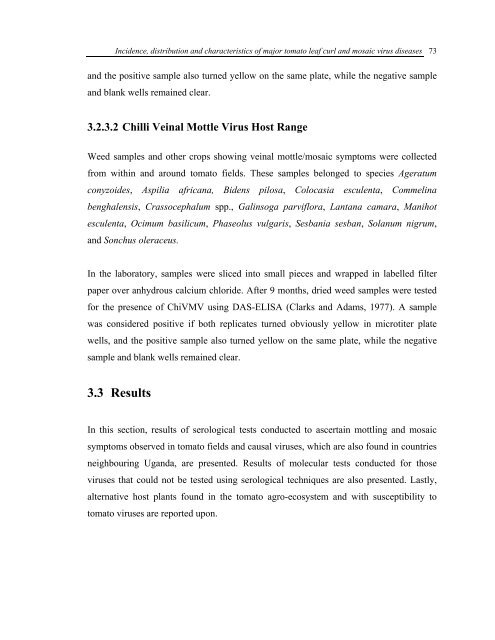Incidence, Distribution and Characteristics of Major Tomato Leaf ...
Incidence, Distribution and Characteristics of Major Tomato Leaf ...
Incidence, Distribution and Characteristics of Major Tomato Leaf ...
You also want an ePaper? Increase the reach of your titles
YUMPU automatically turns print PDFs into web optimized ePapers that Google loves.
<strong>Incidence</strong>, distribution <strong>and</strong> characteristics <strong>of</strong> major tomato leaf curl <strong>and</strong> mosaic virus diseases<br />
<strong>and</strong> the positive sample also turned yellow on the same plate, while the negative sample<br />
<strong>and</strong> blank wells remained clear.<br />
3.2.3.2 Chilli Veinal Mottle Virus Host Range<br />
Weed samples <strong>and</strong> other crops showing veinal mottle/mosaic symptoms were collected<br />
from within <strong>and</strong> around tomato fields. These samples belonged to species Ageratum<br />
conyzoides, Aspilia africana, Bidens pilosa, Colocasia esculenta, Commelina<br />
benghalensis, Crassocephalum spp., Galinsoga parviflora, Lantana camara, Manihot<br />
esculenta, Ocimum basilicum, Phaseolus vulgaris, Sesbania sesban, Solanum nigrum,<br />
<strong>and</strong> Sonchus oleraceus.<br />
In the laboratory, samples were sliced into small pieces <strong>and</strong> wrapped in labelled filter<br />
paper over anhydrous calcium chloride. After 9 months, dried weed samples were tested<br />
for the presence <strong>of</strong> ChiVMV using DAS-ELISA (Clarks <strong>and</strong> Adams, 1977). A sample<br />
was considered positive if both replicates turned obviously yellow in microtiter plate<br />
wells, <strong>and</strong> the positive sample also turned yellow on the same plate, while the negative<br />
sample <strong>and</strong> blank wells remained clear.<br />
3.3 Results<br />
In this section, results <strong>of</strong> serological tests conducted to ascertain mottling <strong>and</strong> mosaic<br />
symptoms observed in tomato fields <strong>and</strong> causal viruses, which are also found in countries<br />
neighbouring Ug<strong>and</strong>a, are presented. Results <strong>of</strong> molecular tests conducted for those<br />
viruses that could not be tested using serological techniques are also presented. Lastly,<br />
alternative host plants found in the tomato agro-ecosystem <strong>and</strong> with susceptibility to<br />
tomato viruses are reported upon.<br />
73





